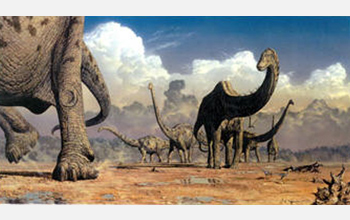Multimedia Gallery
"The Long March"
This painting, titled "The Long March," depicts a herd of sauropod dinosaurs, Seismosaurus (Diplodocus) hallorum, migrating to new feeding areas during the seasonally dry environment of western North America's late Jurassic Period. A huge skeleton of Seismosaurus (40 percent complete) was found in the Brushy Basin Member of New Mexico's Morrison Formation by paleontologists David Gillette and Wilson Bechtel. Associated with the skeleton were gastroliths, or "stomach stones," that may have aided digestion.
Credit: "The Long March" (Seismosaurus) ©1994 Mark Hallett. All Rights Reserved. [Artist's permission is required to reproduce art images. Please contact MARK HALLETT PALEOART via email at marksabercat@q.com; or by telephone, (503) 831-1164.]
See other images like this on your iPhone or iPad download NSF Science Zone on the Apple App Store.
Special Restrictions: Credit line must be printed adjacent to all image reproductions/usages, as stated by the owner.
Images and other media in the National Science Foundation Multimedia Gallery are available for use in print and electronic material by NSF employees, members of the media, university staff, teachers and the general public. All media in the gallery are intended for personal, educational and nonprofit/non-commercial use only.
Images credited to the National Science Foundation, a federal agency, are in the public domain. The images were created by employees of the United States Government as part of their official duties or prepared by contractors as "works for hire" for NSF. You may freely use NSF-credited images and, at your discretion, credit NSF with a "Courtesy: National Science Foundation" notation.
Additional information about general usage can be found in Conditions.
Also Available:
Download the high-resolution JPG version of the image. (8.5 MB)
Use your mouse to right-click (Mac users may need to Ctrl-click) the link above and choose the option that will save the file or target to your computer.



